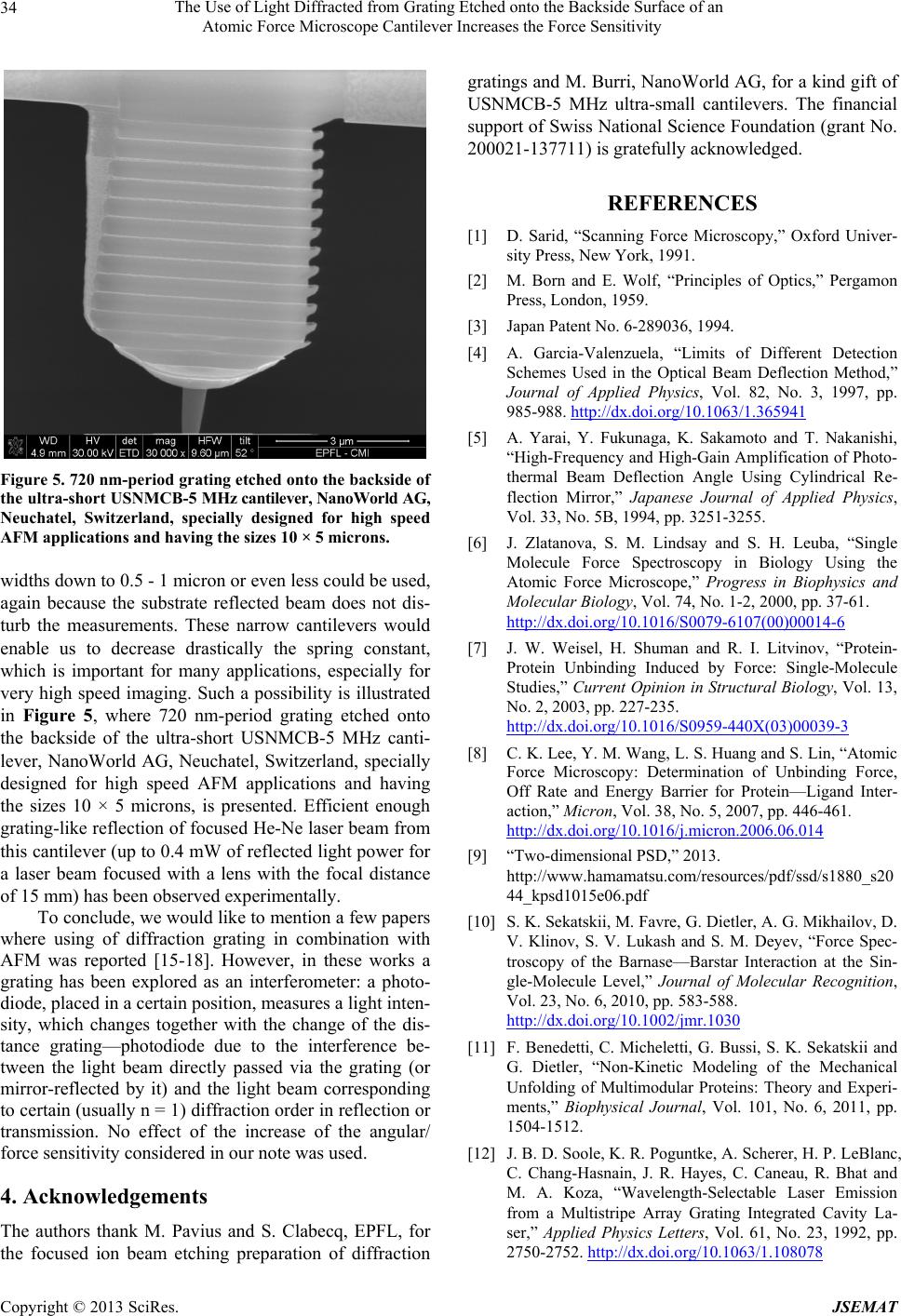
The Use of Light Diffracted from Grating Etched onto the Backside Surface of an
Atomic Force Microscope Cantilever Increases the Force Sensitivity
Copyright © 2013 SciRes. JSEMAT
34
Figure 5. 720 nm-period grating etched onto the backside of
the ultra-short USNMCB-5 MHz cantilever, NanoWorld AG,
Neuchatel, Switzerland, specially designed for high speed
AFM applications and having the sizes 10 × 5 microns.
widths down to 0.5 - 1 micron or even less could be used,
again because the substrate reflected beam does not dis-
turb the measurements. These narrow cantilevers would
enable us to decrease drastically the spring constant,
which is important for many applications, especially for
very high speed imaging. Such a possibility is illustrated
in Figure 5, where 720 nm-period grating etched onto
the backside of the ultra-short USNMCB-5 MHz canti-
lever, NanoWorld AG, Neuchatel, Switzerland, specially
designed for high speed AFM applications and having
the sizes 10 × 5 microns, is presented. Efficient enough
grating-like reflection of focused He-Ne laser beam from
this cantilever (up to 0.4 mW of reflected light power for
a laser beam focused with a lens with the focal distance
of 15 mm) has been observed experimentally.
To conclude, we would like to mention a few papers
where using of diffraction grating in combination with
AFM was reported [15-18]. However, in these works a
grating has been explored as an interferometer: a photo-
diode, placed in a certain position, measures a light inten-
sity, which changes together with the change of the dis-
tance grating—photodiode due to the interference be-
tween the light beam directly passed via the grating (or
mirror-reflected by it) and the light beam corresponding
to certain (usually n = 1) diffraction order in reflection or
transmission. No effect of the increase of the angular/
force sensitivity considered in our note was used.
4. Acknowledgements
The authors thank M. Pavius and S. Clabecq, EPFL, for
the focused ion beam etching preparation of diffraction
gratings and M. Burri, NanoWorld AG, for a kind gift of
USNMCB-5 MHz ultra-small cantilevers. The financial
support of Swiss National Science Foundation (grant No.
200021-137711) is gratefully acknowledged.
REFERENCES
[1] D. Sarid, “Scanning Force Microscopy,” Oxford Univer-
sity Press, New York, 1991.
[2] M. Born and E. Wolf, “Principles of Optics,” Pergamon
Press, London, 1959.
[3] Japan Patent No. 6-289036, 1994.
[4] A. Garcia-Valenzuela, “Limits of Different Detection
Schemes Used in the Optical Beam Deflection Method,”
Journal of Applied Physics, Vol. 82, No. 3, 1997, pp.
985-988. http://dx.doi.org/10.1063/1.365941
[5] A. Yarai, Y. Fukunaga, K. Sakamoto and T. Nakanishi,
“High-Frequency and High-Gain Amplification of Photo-
thermal Beam Deflection Angle Using Cylindrical Re-
flection Mirror,” Japanese Journal of Applied Physics,
Vol. 33, No. 5B, 1994, pp. 3251-3255.
[6] J. Zlatanova, S. M. Lindsay and S. H. Leuba, “Single
Molecule Force Spectroscopy in Biology Using the
Atomic Force Microscope,” Progress in Biophysics and
Molecular Biology, Vol. 74, No. 1-2, 2000, pp. 37-61.
http://dx.doi.org/10.1016/S0079-6107(00)00014-6
[7] J. W. Weisel, H. Shuman and R. I. Litvinov, “Protein-
Protein Unbinding Induced by Force: Single-Molecule
Studies,” Current Opinion in Structural Biology, Vol. 13,
No. 2, 2003, pp. 227-235.
http://dx.doi.org/10.1016/S0959-440X(03)00039-3
[8] C. K. Lee, Y. M. Wang, L. S. Huang and S. Lin, “Atomic
Force Microscopy: Determination of Unbinding Force,
Off Rate and Energy Barrier for Protein—Ligand Inter-
action,” Micron, Vol. 38, No. 5, 2007, pp. 446-461.
http://dx.doi.org/10.1016/j.micron.2006.06.014
[9] “Two-dimensional PSD,” 2013.
http://www.hamamatsu.com/resources/pdf/ssd/s1880_s20
44_kpsd1015e06.pdf
[10] S. K. Sekatskii, M. Favre, G. Dietler, A. G. Mikhailov, D.
V. Klinov, S. V. Lukash and S. M. Deyev, “Force Spec-
troscopy of the Barnase—Barstar Interaction at the Sin-
gle-Molecule Level,” Journal of Molecular Recognition,
Vol. 23, No. 6, 2010, pp. 583-588.
http://dx.doi.org/10.1002/jmr.1030
[11] F. Benedetti, C. Micheletti, G. Bussi, S. K. Sekatskii and
G. Dietler, “Non-Kinetic Modeling of the Mechanical
Unfolding of Multimodular Proteins: Theory and Experi-
ments,” Biophysical Journal, Vol. 101, No. 6, 2011, pp.
1504-1512.
[12] J. B. D. Soole, K. R. Poguntke, A. Scherer, H. P. LeBlanc,
C. Chang-Hasnain, J. R. Hayes, C. Caneau, R. Bhat and
M. A. Koza, “Wavelength-Selectable Laser Emission
from a Multistripe Array Grating Integrated Cavity La-
ser,” Applied Physics Letters, Vol. 61, No. 23, 1992, pp.
2750-2752. http://dx.doi.org/10.1063/1.108078